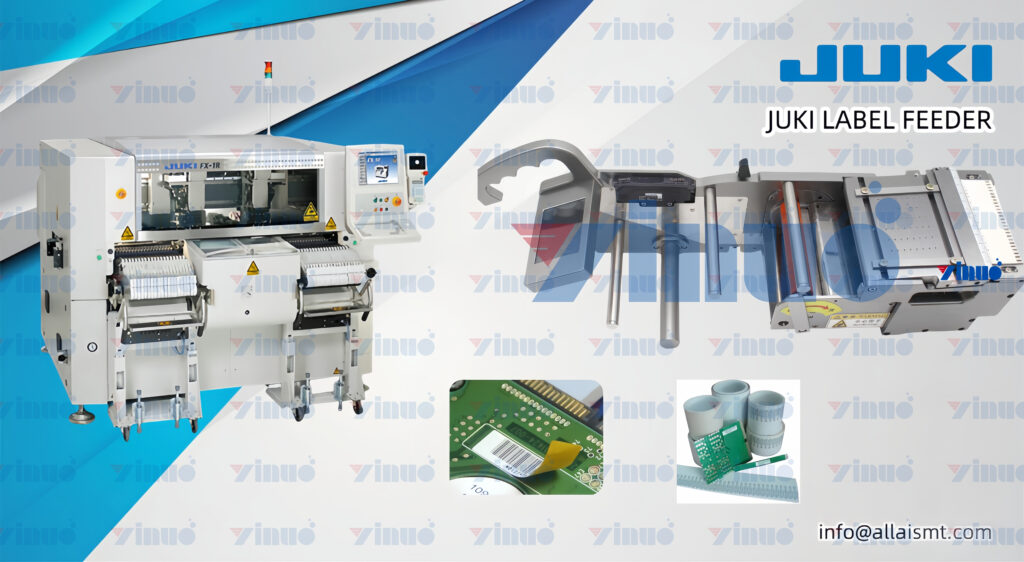JUKI Label Feeders: Reducing the Complexity of Label Management
Introduction
In modern manufacturing environments, label management can be a complex and resource-intensive task. Labels are essential for product identification, compliance, traceability, and branding, but managing the labeling process efficiently while maintaining accuracy and consistency is often a challenge. This is especially true for manufacturers dealing with large volumes of products or high variability in product types. JUKI label feeders are a powerful solution to this problem, simplifying the complexity of label management by automating processes, reducing errors, and improving overall efficiency. This article explores how JUKI label feeders help streamline label management, making it easier for manufacturers to meet production demands while ensuring high standards of quality and compliance.
Automating the Labeling Process
1. Streamlined Integration into Production Lines
JUKI label feeders are designed to integrate seamlessly into existing production lines, automating the application of labels onto products without interrupting the flow of manufacturing. This integration reduces the need for manual intervention and simplifies the entire labeling process. By automating label application, JUKI feeders eliminate bottlenecks in production, allowing manufacturers to focus on other critical aspects of their operations.
2. Simplifying Complex Labeling Tasks
Managing multiple types of labels—such as barcodes, QR codes, regulatory labels, and brand labels—can be overwhelming, especially in industries where products must meet specific legal and market requirements. JUKI label feeders are capable of handling different label types with precision, making it easier to apply complex labels quickly and accurately. This capability reduces the complexity of managing multiple label formats and ensures that products are labeled according to specifications every time.
Improving Accuracy and Reducing Errors
1. Minimizing Human Error
One of the primary challenges of manual label management is the potential for human error. Misaligned labels, incorrect label application, or even labeling the wrong product can lead to costly mistakes, including rework, recalls, or even regulatory fines. JUKI label feeders automate the process, dramatically reducing the risk of errors. The precise, automated application of labels ensures that each product is correctly labeled, improving accuracy and reducing the need for costly interventions.
2. Consistent Label Placement
Uniformity in label placement is critical for both branding and compliance purposes. Labels that are crooked or misplaced can affect the appearance of the product and even lead to problems in automated scanning systems used in supply chains or retail environments. JUKI label feeders ensure consistent placement of labels, maintaining the aesthetic and functional quality of the product, which is crucial for both consumer trust and operational efficiency.
Enhancing Flexibility and Scalability
1. Adaptability to Different Product Types
In many industries, manufacturers must handle a wide variety of products that require different types of labeling. Managing these variations manually can be complex and time-consuming. JUKI label feeders offer flexibility by being adaptable to different product sizes, shapes, and label requirements. This adaptability makes it easier for manufacturers to scale their operations and manage the complexity of diverse product lines without sacrificing efficiency.
2. Quick Changeovers for Batch Production
For manufacturers working in batch production, frequent changeovers between product lines are often necessary. JUKI label feeders are designed to facilitate quick and easy changeovers, allowing manufacturers to switch between different label formats or products with minimal downtime. This ability to quickly adapt to different production requirements helps reduce the complexity associated with managing multiple batches and improves overall productivity.
Compliance and Traceability Made Simple
1. Ensuring Regulatory Compliance
Maintaining compliance with industry regulations is critical, especially in sectors such as electronics, pharmaceuticals, and food production. Managing the complexity of compliance-related labeling can be daunting, as labels must meet specific standards and include all necessary information, such as expiration dates, safety warnings, and certification marks. JUKI label feeders automate this process, ensuring that each product is labeled according to the latest regulations, reducing the risk of non-compliance and associated penalties.
2. Enhancing Product Traceability
In today’s global supply chains, traceability is essential for ensuring product quality and managing recalls effectively. JUKI label feeders allow for the application of unique identifiers, such as serial numbers, barcodes, and batch numbers, which are crucial for tracking products through the production process and supply chain. This automated traceability reduces the complexity of managing product information and helps manufacturers maintain better control over their supply chain, improving both accountability and consumer safety.
Boosting Efficiency and Reducing Costs
1. Reducing Labor Costs
Manual label application requires a significant amount of labor, from positioning and applying the labels to checking for errors and reworking products when mistakes occur. JUKI label feeders automate this entire process, significantly reducing the need for manual labor and the associated costs. By freeing up workers from the tedious task of labeling, manufacturers can allocate their labor resources more effectively, focusing on higher-value tasks that contribute to overall productivity and profitability.
2. Minimizing Waste
Errors in label management can lead to waste, whether it’s due to mislabeling or incorrect label placement that renders a product unsellable. JUKI label feeders reduce waste by ensuring that labels are applied correctly the first time, minimizing the need for rework or discarding mislabeled products. This efficiency not only cuts costs but also contributes to more sustainable manufacturing practices by reducing material waste.
Conclusion
JUKI label feeders offer manufacturers a powerful tool for reducing the complexity of label management. By automating the labeling process, minimizing errors, and providing flexibility to adapt to different product types and regulatory requirements, JUKI feeders streamline operations and improve efficiency. The result is a simplified label management process that enhances accuracy, reduces costs, and ensures compliance—ultimately leading to higher productivity and greater consumer trust in the products being delivered to the market.


